Posts categorized “Programming”.
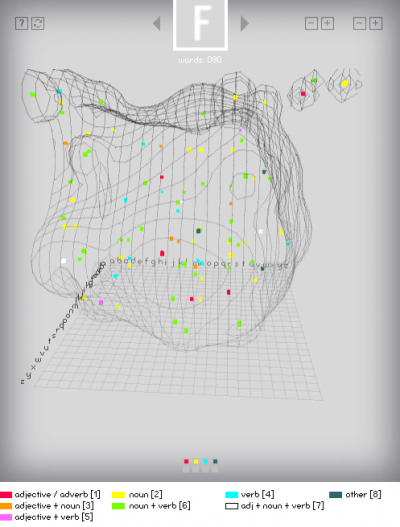
http://toxi.co.uk/p5/base26
Because four-letter words have a special status in the English language and culture ‘base26′ was done to give an overview of (almost) all English four-letter words and to visualize their relations to each other.
Each point is a presentation for a four-letter-word with a position based on 4D coordinates for x,y,z and time. The colors indicate types of words and the wireframe surface depicts the frequency of occurence of letter combinations. (toxi.co.uk/p5/base26)
Posted on December 12th, 2008.
Categories: Generated, Processing, Programming, Research.
...................................................................................................................................
End of November the first non-beta version of Processing (1.0) got released. With it I am using the latest version of Geomerative now (ref 19). Ricard Marxer was so kind as to provide additional functions for me so that I could translate some
fundamental functionality from my previous code.
The preceding versions have features though that I appreciate and that’s why I will keep working with them. Intersection works well and contours have no closure - essential aspects when line-drawing.
Font-metrics and -formatting seem still be some rare topics among programmers. I can apply kerning by bringing in the kerning-pair information out of the metrics file of a font. And I did some very basic alignment for body text that suits my needs. At the same time Christian Rieckoff was working on automatic line-breaking in java what might be worth a bookmark for future plans. (texone.org/?p=43)
Christian Rieckhoff educates at the UDK Berlin and held a Processing course on digital fabrication in Summer in which he provided some very helpful code examples.
Posted on December 7th, 2008.
Categories: News, Processing, Programming, Research, Resources.
...................................................................................................................................

A new version (0150 BETA) of Processing got released today. It has many major changes to the previous (0148) and seems to have better support for vector and svg. Some libraries will have to be updated though. However - this gives me enough reason to list some of the libraries that drew my attention:
NextText (classes especially for text-based applications) uses TrueType fonts to render and display dynamic and interactive text.
(www.nexttext.net)
Geomerative (classes enabling extended 2D geometry operations)
also implements a TrueType font interpreter and importer to support the usage of typography in generative art.
(www.ricardmarxer.com/geomerative)
physics (classes enabling the simulation of physics) let you realize particle systems and forces more easily.
http://www.cs.princeton.edu/~traer/physics/
arcball (classes enabling easy 3D navigation) allows to freely rotate space along all three axes.
controlP5(classes enabling to implement controller easily) allows instant chance and feedback to different values for behavior parameters etc.
(www.sojamo.de/libraries/controlP5)
Posted on October 15th, 2008.
Categories: Processing, Programming, Research, Resources, Tools.
...................................................................................................................................
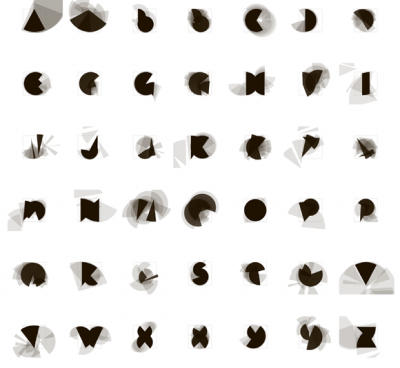
http://typotopo.com/projects.php?id=typemenot
An early example of computational typography by Peter Cho.
Program online:
acg.media.mit.edu/people/pcho/typemenot
Posted on October 11th, 2008.
Categories: Interactive, Programming, Research.
...................................................................................................................................

http://farm4.static.flickr.com/3070/2639346406_07acfa10f1.jpg?v=0
Programmed Typography titled ’schim.’ by Manuela Strauss
Posted on October 11th, 2008.
Categories: Generated, Processing, Programming, Research.
...................................................................................................................................
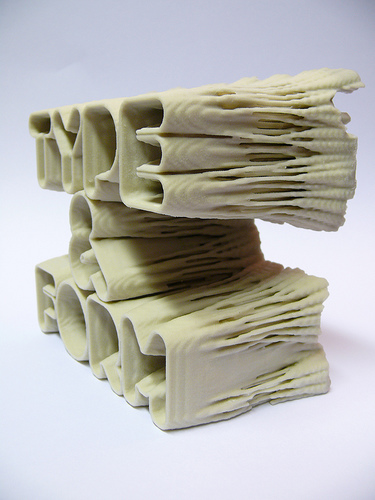
http://www.flickr.com/photos/toxi/2635536163/
PostSpectacular realized the Print magazine August 2008 cover by designing and digitally fabricating a typographic sculpture using generative form giving. With this work they also indicated the changing scope of ‘print’. The process is part of the artwork and therefore documented as making-of on http://postspectacular.com/process/20080702_printmagcover
Posted on October 11th, 2008.
Categories: Generated, Programming, Research.
...................................................................................................................................
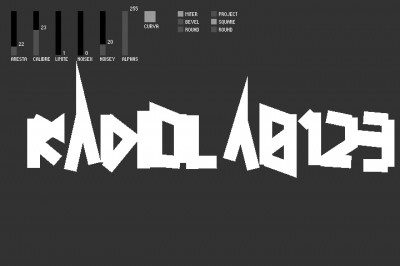
http://dmtr.org/syntype/
Dimitre Lima programmed a basic visual typography synthesizer in Processing. You can animate the type’s shape by applying different values of transformation degrees.
Posted on October 11th, 2008.
Categories: Interactive, Processing, Programming, Research.
...................................................................................................................................
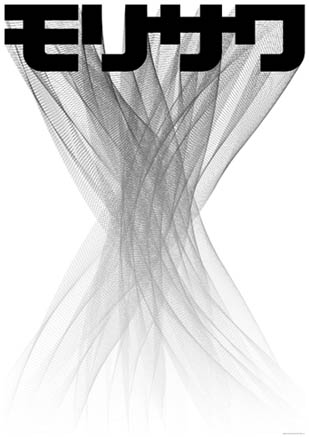
www.maedastudio.com/1996/gggkami/mori6.jpg
Some early work of John Maeda is done by Postscript programming. A series of posters show various examples.
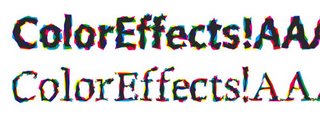
http://bp0.blogger.com/_jQ3w5UYYX5A/RaIP1wox03I/AAAAAAAAAAM/LlqyguU-qRU/s320/RandomFontColorEffects.jpg
Just van Rossum and Erik van Blokland (LettError) built the Typeface Beowolf as their first ‘RandomFont’.
They apply random functions to the letterforms when printing. Thus you get an individual shape for each letter. Computer fonts are rather dynamic programs than static forms. The two designers admit that the random aesthetic here is not that appealing, but the project was “proof that fonts were no longer physical objects but instructions.” (Interviews 1: Print, p.170, Processing. A Programming Handbook for Visual Designers and Artists, 2007 MIT)
http://www.letterror.com/content/nypels/randomfont.html
Posted on October 8th, 2008.
Categories: Generated, Processing, Programming, Research.
...................................................................................................................................
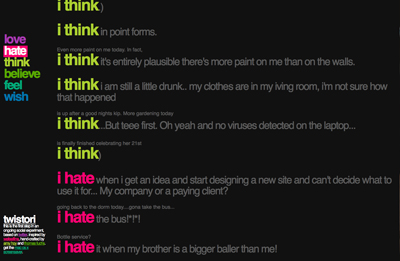
http://twistori.com
Twitter seemed to me to be a potential source of brief messages taken from various people in various places at the same time. The increasing number of applications around the so called tweets show it is also relatively straight forward to get the desired text input from Twitter as the feed is it’s main task.
Twistori is an application that uses messages posted on Twitter for a social experiment. It filters posts optionally by the usage of the words “love, hate, think, believe, feel, wish” and thus realizes a ticker on community’s emotions expressed in sentences containing one of those key words.
Posted on September 21st, 2008.
Categories: Favorites, Programming, Research.
...................................................................................................................................
Posted on September 21st, 2008.
Categories: Inspiration, Programming, Research.
...................................................................................................................................








